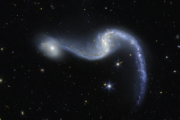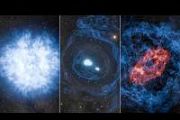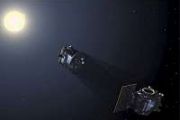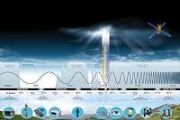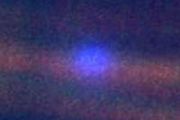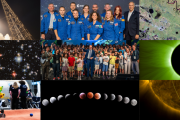
Copernical Team
China's new Long March rockets to enable lunar and Mars missions
 China's next-generation Long March 10 carrier rocket will significantly boost the nation's capacity for manned lunar exploration, increasing its lunar transfer orbit payload from 8.2 tonnes to 27 tonnes, according to Long Lehao, a prominent rocket designer at the China Academy of Launch Vehicle Technology (CALT).
Long explained that the Long March 10 is specifically being designed to suppo
China's next-generation Long March 10 carrier rocket will significantly boost the nation's capacity for manned lunar exploration, increasing its lunar transfer orbit payload from 8.2 tonnes to 27 tonnes, according to Long Lehao, a prominent rocket designer at the China Academy of Launch Vehicle Technology (CALT).
Long explained that the Long March 10 is specifically being designed to suppo NASA administrator reaches for the stars while navigating budgets and politics
 Leaders of NASA sit in an awkward position. While they are the head of a widely recognized organization, they're often not the most famous individual in the agency. More people probably know the names of Butch Wilmore and Suni Williams, the astronauts currently "stranded" on the International Space Station, than Bill Nelson, the current NASA administrator.
Astronauts might be the people mo
Leaders of NASA sit in an awkward position. While they are the head of a widely recognized organization, they're often not the most famous individual in the agency. More people probably know the names of Butch Wilmore and Suni Williams, the astronauts currently "stranded" on the International Space Station, than Bill Nelson, the current NASA administrator.
Astronauts might be the people mo China observatory documents asteroid before entering Earth's atmosphere
 An astronomical observatory in Yunnan Province, southwest China, has successfully documented the rare event of a near-Earth asteroid falling to Earth, according to an announcement by the Chinese Academy of Sciences (CAS).
The Lijiang branch of the CAS Yunnan Observatories detected asteroid 2024 XA1 at 13:55 Beijing time on December 3 using its advanced 2.4-meter telescope. Hours later, at
An astronomical observatory in Yunnan Province, southwest China, has successfully documented the rare event of a near-Earth asteroid falling to Earth, according to an announcement by the Chinese Academy of Sciences (CAS).
The Lijiang branch of the CAS Yunnan Observatories detected asteroid 2024 XA1 at 13:55 Beijing time on December 3 using its advanced 2.4-meter telescope. Hours later, at 3D printable bioreactor designs to support space nutrition
 NASA's Synthetic Biology Project is collaborating with the GrabCAD community to create innovative 3D-printable bioreactor designs. These bioreactors aim to reduce the mass and volume of supplies needed for extended space missions by enabling in-situ production of essential nutrients through reusable or recyclable solutions.
The project focuses on enhancing BioNutrient Production Packs, whi
NASA's Synthetic Biology Project is collaborating with the GrabCAD community to create innovative 3D-printable bioreactor designs. These bioreactors aim to reduce the mass and volume of supplies needed for extended space missions by enabling in-situ production of essential nutrients through reusable or recyclable solutions.
The project focuses on enhancing BioNutrient Production Packs, whi What went wrong? NASA conducts first aircraft accident probe on another planet
This request seems a bit unusual, so we need to confirm that you're human. Please press and hold the button until it turns completely green. Thank you for your cooperation!
Press and hold the button
If you believe this is an error, please contact our support team.
185.132.36.159 : 3c9d8528-cd20-427f-834e-00c98420
Strategic alliance brings high-energy nuclear electric propulsion closer to reality
This request seems a bit unusual, so we need to confirm that you're human. Please press and hold the button until it turns completely green. Thank you for your cooperation!
Press and hold the button
If you believe this is an error, please contact our support team.
185.132.36.159 : 022f99f5-7b47-4e2e-9740-8888bbb4
How to catch the Geminids, one of the strongest meteor showers of the year
This request seems a bit unusual, so we need to confirm that you're human. Please press and hold the button until it turns completely green. Thank you for your cooperation!
Press and hold the button
If you believe this is an error, please contact our support team.
185.132.36.159 : d494a5fe-d1e8-4223-9bea-bc453b33
AI-powered satellite data reveals clouds in 3D

Launched in May 2024, ESA’s EarthCARE satellite is nearing the end of its commissioning phase with the release of its first data on clouds and aerosols expected early next year. In the meantime, an international team of scientists has found an innovative way of applying artificial intelligence to other satellite data to yield 3D profiles of clouds.
This is particularly news for those eagerly awaiting data from EarthCARE in their quest to advance climate science.
Paxi explores ice
 Video:
00:04:04
Video:
00:04:04
English Paxi explores ice
Join Paxi on an adventure to the North and South poles, to learn more about ice and its role in keeping Earth cool.
Italian Paxi osserva il ghiaccio
Unisciti a Paxi in un'avventura ai poli Nord e Sud, per saperne di più sul ghiaccio e sul suo ruolo nel mantenere la Terra fresca.
German Paxi erforscht das Eis
Begleiten Sie Paxi auf ein Abenteuer zum Nord- und Südpol, um mehr über Eis und seine Rolle bei der Kühlung der Erde zu erfahren.
French Paxi explore la glace
Rejoignez Paxi dans une aventure aux pôles Nord et Sud, pour en savoir plus sur la glace
Webb finds primeval star-forming galaxy that is lightweight

For the first time, the NASA/ESA/CSA James Webb Space Telescope has detected and ‘weighed’ a galaxy, in the early Universe, that has a mass that is similar to what our Milky Way galaxy’s mass might have been at the same stage of development. Found at around 600 million years after the Big Bang, this lightweight galaxy, nicknamed the Firefly Sparkle, is gleaming with star clusters – 10 in total – that researchers examined in great detail. Other galaxies Webb has detected at this period in the history of the Universe are significantly more massive.













